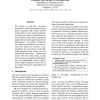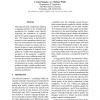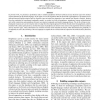COLING
2010
13 years 9 months ago
2010
This paper proposes a method that leverages multiple machine translation (MT) engines for paraphrase generation (PG). The method includes two stages. Firstly, we use a multi-pivot...
COLING
2010
13 years 9 months ago
2010
We describe a new unsupervised approach for synonymy discovery by aligning paraphrases in monolingual domain corpora. For that purpose, we identify phrasal terms that convey most ...
ACL
2009
14 years 15 days ago
2009
In this paper, we study the problem of extracting technical paraphrases from a parallel software corpus, namely, a collection of duplicate bug reports. Paraphrase acquisition is a...
ACL
2009
14 years 15 days ago
2009
We present a novel approach to deciding whether two sentences hold a paraphrase relationship. We employ a generative model that generates a paraphrase of a given sentence, and we ...
ACL
2010
14 years 21 days ago
2010
Lattice decoding in statistical machine translation (SMT) is useful in speech translation and in the translation of German because it can handle input ambiguities such as speech r...
EMNLP
2006
14 years 4 months ago
2006
We propose a supervised, two-phase framework to address the problem of paraphrase recognition (PR). Unlike most PR systems that focus on sentence similarity, our framework detects...
ACL
2006
14 years 4 months ago
2006
This paper presents a method for adapting a language generator to the strengths and weaknesses of a synthetic voice, thereby improving the naturalness of synthetic speech in a spo...
EMNLP
2008
14 years 4 months ago
2008
We improve the quality of paraphrases extracted from parallel corpora by requiring that phrases and their paraphrases be the same syntactic type. This is achieved by parsing the E...
LREC
2010
14 years 4 months ago
2010
In previous work, we presented a preliminary study to identify paraphrases between technical and lay discourse types from medical corpora dedicated to the French language. In this...
FLAIRS
2007
14 years 5 months ago
2007
Paraphrase detection can be seen as the task of aligning sentences that convey the same information but yet are written in different forms. Such resources are important to automat...



